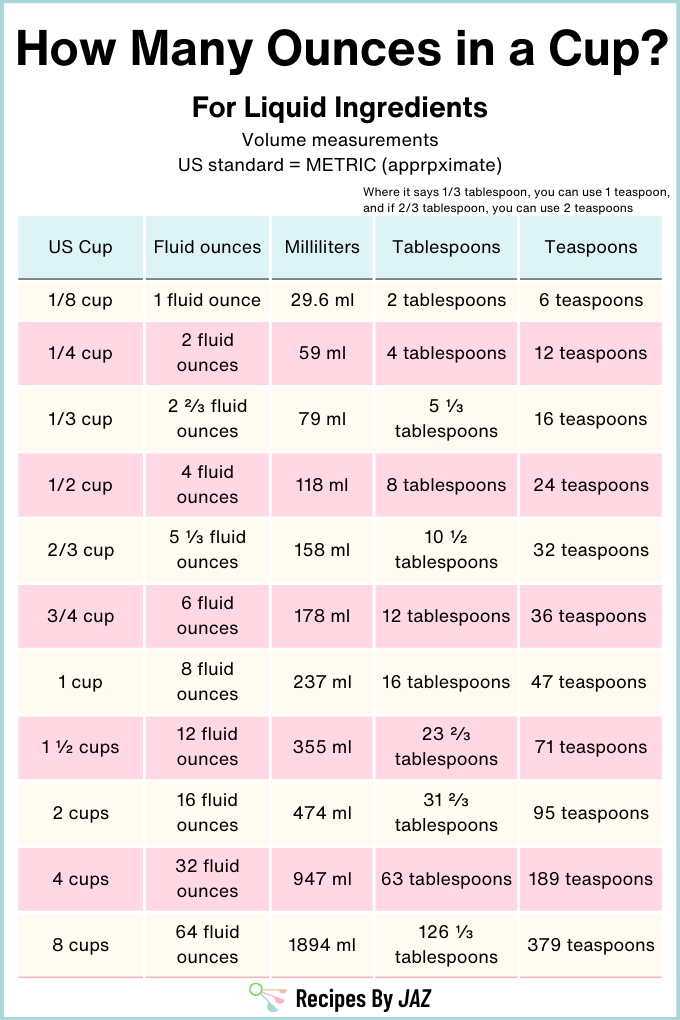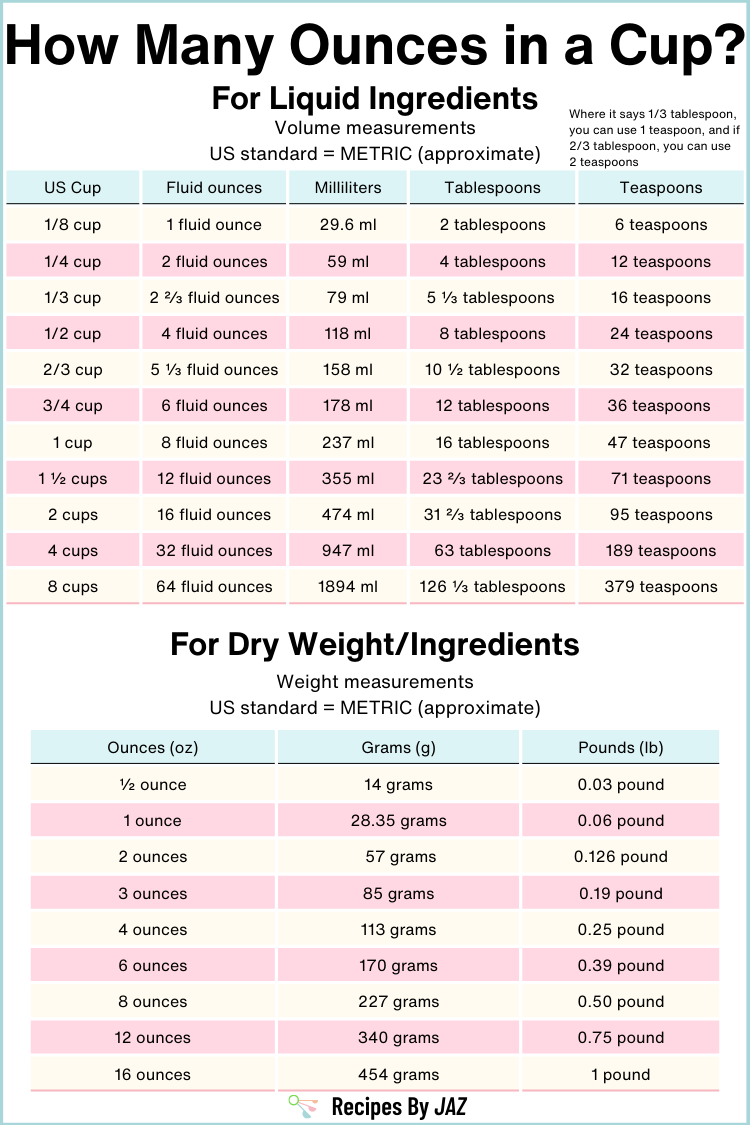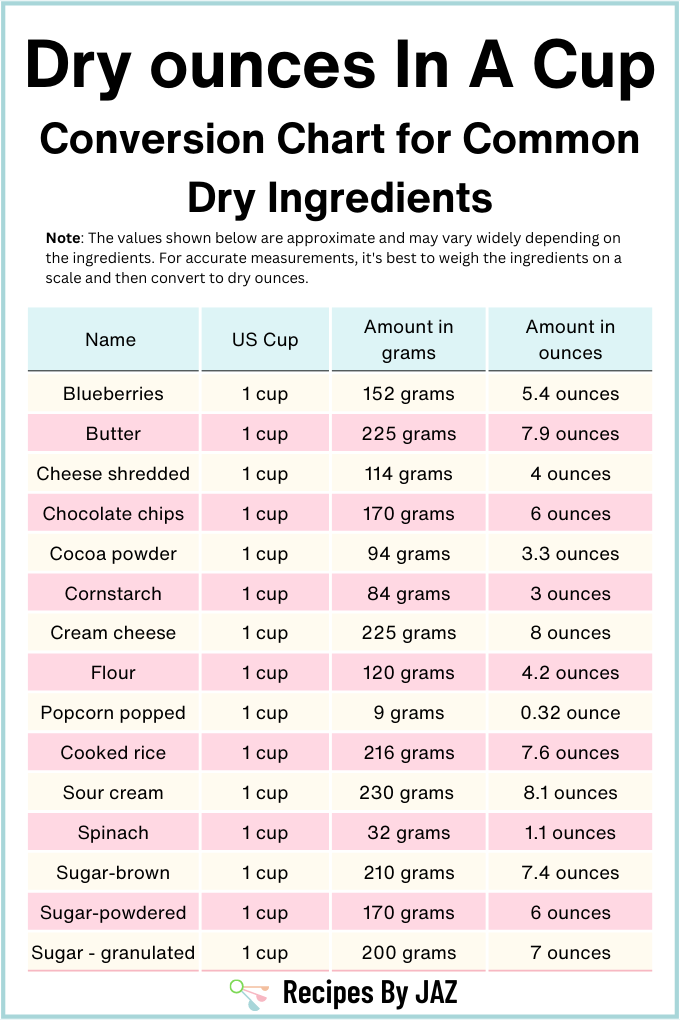Do you want to know how many ounces are in a cup? Want to know the difference between fluid and dry ounces? This comprehensive guide will help you understand the measuring systems used in cooking and baking. There are multiple charts in this post that you can save and use as a reference.

Perfect measurements are one of the important steps to getting that perfect dish. A common question is about how many ounces are in a cup.
Well, the answer varies depending on whether the ingredient in question is liquid or dry. Not to mention, these measurements may also vary from country to country depending on the measurement system.
Long story short, below are the key points but keep reading to know all the details for once and all.
Key points
- One cup has 8 fluid ounces. (Note: it is fluid ounces, so it is only for liquids like water, tea, or milk and the cup here refers to the US cup size)
- The number of dry ounces in a cup will vary depending on the dry ingredient (which includes flour, almonds, etc.). For example, 1 cup of flour contains 4.2 ounces while 1 cup of powdered sugar contains 6 ounces.
- For dry ingredients, it’s best to use a measuring cup and weigh it on a scale. Divide the weight value in grams by 28.35 (use factor 30 for easy calculations) to get ounces in a cup. (For your reference, there is a chart later in the article which includes common dry ingredients)
Moving on to the details!!
What is an ounce?
An ounce is a unit of measurement that can be used to quantify both liquid and dry ingredients. As a unit of weight, an ounce is approximately 28.35 grams.
A fluid ounce is used for fluids and it is the measure of volume rather than weight. In the U.S. system, one fluid ounce equals approximately 29.57 milliliters.
Fluid ounces vs dry ounces
The term ‘fluid ounces’ is a measure of volume, typically used for liquids, while ‘dry ounces’ is a measure of weight, generally used for dry ingredients.
Tools and equipment
For the right measurements, you will need the right tools. If you are a passionate cook, the following tools can make your cooking a lot easier.
1. Liquid measuring cups
As the name suggests, these help us to measure liquids with accuracy. These cups are typically made of clear glass or plastic and have a pouring spout. You will be able to see the clear markings on the cup, usually ranging from ¼ cup and above.
The clear material helps you see the level of liquid which helps to measure an ingredient accurately.
Note: Cup sizes in US and UK are quite different from each other. So, when measuring make sure you are using the right cup sizes.
American Measuring Cups: In the US, the Imperial system is used which includes ounces and cups. There are two main US cup sizes:
- The US customary cup, which is 237 ml, is often used for cooking.
- The US legal cup, which is 240 ml, is used for nutritional labels by the Food and Drug Administration.
British Measuring Cups: In the UK, the metric system is used which includes grams and kilograms for weight, or milliliters and liters for volume. In older British recipes the UK cup was 10 Imperial fluid ounces, which is approximately 284 milliliters. However, most new recipes use metric cups.
- 1 UK cup (metric system) = 250 ml
- Quick tips
- If you are based in the US and are making a UK-based recipe, use the US cup and add 2 teaspoons.
- If you are based in the UK and are making a US-based recipe, use the UK cup and remove 2 teaspoons.
2. Dry measuring cups
These are usually made of metal or plastic cups and are designed for measuring dry ingredients. They come in a set that usually includes a ¼ cup, ⅓ cup, ½ cup, and 1 cup. Some sets will include bigger cups.
For accurate measuring, it is important to level off the top. That means once you fill the cup, use a flat spatula or straight edge of a knife to make the top flat and remove any excess.
If you are going to make any change to the ingredient do that before measuring. For example: If the recipe calls for ground almonds, make sure to use the exact thing. Do not measure whole almonds, and then grind them. The reason is that, both these ingredients will pack differently in a cup so the weight measures will vary drastically.
Similarly, if you are going to sift flour, do that before taking any measurements.
3. Measuring spoons
These are like dry measuring cups but these are spoons instead of a cup. These are used to measure small quantities and can be used for both dry and liquid ingredients.
4. Spatula or anything with a straight edge
These can help you in leveling dry ingredients in a measuring cup. You don’t need to buy anything specifically. We have a number of utensils in our kitchen which can serve the purpose like the straight edge of a knife.
5. Kitchen scale
Online charts can be useful for cooking, but for recipes that require precise measurements, such as baking, a kitchen scale is invaluable. It can help you measure the dry ingredients accurately.
Note: For best results, it is important to use the right measuring cups, liquid measuring cups for liquid ingredients, and dry measuring cups for dry ingredients.
If you try measuring dry ingredients in a liquid cup, you may not get the right measurements as it is hard to level the dry ingredients in a liquid cup. Similarly, measuring liquid ingredients in dry measuring cups can be challenging as you have to fill the liquid until the brim which can result in spillage.
How to fill and measure in a liquid measuring cup?
Liquid measuring cups should ideally be used only for fluids for the right measurements. In addition, the pouring spout makes it easy to transfer the liquids without spilling.
- Step 1: Keep the measuring cup on a flat surface and pour the liquid up to the desired marking.
- Step 2: Now check the level by aligning your eyes to the desired marking by bending. Most liquids including water will have a concave meniscus (due to surface tension), that is the edges will appear raised than the center. Your desired marking should align with the center of the meniscus for the most accurate measurement.
- Step 3: If the level is more or less than your desired marking, adjust the amount by pouring more in or out of the cup.
If you are trying to measure a very small quantity, it’s best to use a measuring spoon.
How to fill and measure in a dry measuring cup?
There are several methods to measure dry ingredients, and the appropriate method depends on the type of ingredient. For instance, you can use the spoon and level method for flour and the dip and sweep method for sugar.
To measure dry ingredients by the dip and sweep method, follow these steps:
- Step 1: Get your measuring cup, dip it into the bag of dry ingredient (such as a container of sugar), and fill it with the ingredient.
- Step 2: Level it using the straight edge of a knife.
- Step 3: When needed, use a kitchen scale for appropriate measurement.
To measure dry ingredients by the spoon and level method, follow these steps:
- Step 1: Get your measuring cup and fill it with the dry ingredient using a spoon.
- Step 2: Level it using the straight edge of a knife.
- Step 3: When needed, use a kitchen scale for appropriate measurement.
How many fluid ounces are in a cup?
One cup contains 8 fluid ounces. The following may help you make the common measurements:
- 1 cup is equal to 8 fluid ounces
- ¾ cup is equal to 6 fluid ounces
- ½ cup is equal to 4 fluid ounces
- ¼ cup is equal to 2 fluid ounces
- ⅛ cup is equal to 1 fluid ounce
The above measurements are true only for liquid ingredients like water, tea, milk, and so on. Dry ounces are different from fluid ounces.

How many dry ounces are in a cup?
Measuring the fluid ounces is more uniform across different liquid ingredients. In comparison, dry ounces will vary depending on the density of the ingredient.
It means that one cup will have different ounces of a dry ingredient.
Let’s take a look at some common examples:
- 1 cup of flour = 4.2 ounces
- 1 cup of popped popcorn = 3 ounces
- 1 cup of chocolate chips = 6 ounces
For accurate measurement, it’s best to fill and level your measuring cup and measure it on the scale. You can divide the value you get in grams by 28.35 (for easier calculation use factor 30) to get dry ounces.

Liquid vs dry measurement conversions with chart
Below you will find handy measurements of liquid and dry ounces. You can also see the chart below, you can either pin it for later use or right-click and save the image (you can print the saved image).

1. For liquid fluids
US Standard = Metric (approximate)
- 1 teaspoon = ⅓ tablespoon = 5 ml
- 1 tablespoon = ½ fluid ounce = 3 teaspoons = 15 ml
- 2 tablespoons = 1 fluid ounce = ⅛ cup = 6 teaspoons = 30 ml
- ⅛ cup = 1 fluid ounces = 2 tablespoons = 6 teaspoons = 29.6 ml
- ¼ cup = 2 fluid ounces = 4 tablespoons = 12 teaspoons = 59 ml
- ⅓ cup = 2 ⅔ fluid ounces = 5 tablespoons + 1 teaspoon = 16 teaspoons = 79 ml
- ½ cup = 4 fluid ounces = 8 tablespoons = 24 teaspoons = 118 ml
- ⅔ cup = 5 ⅓ fluid ounces = 10 ½ tablespoons = 32 teaspoons = 158 ml
- ¾ cup = 6 fluid ounces = 12 tablespoons = 36 teaspoons = 178 ml
- 1 cup = 8 fluid ounces = 16 tablespoons = 47 teaspoons = 237 ml
- 1 ½ cups = 12 fluid ounces = 24 tablespoons + 2 teaspoons = 71 teaspoons = 355 ml
- 2 cups = 16 fluid ounces = 31 tablespoons + 2 teaspoons = 95 teaspoons = 474 ml
- 4 cups = 32 fluid ounces = 63 tablespoons = 947 ml ~ 1 liter
- 8 cups = 64 fluid ounces = 1894 ml ~ 2 liters
2. For dry weight
US Standard = Metric (approximate)
- ½ ounce = 14 grams
- 1 ounce = 28.35 grams
- 2 ounces = 57 grams
- 3 ounces = 85 grams
- 4 ounces = 113 grams = ¼ pound
- 6 ounces = 170 grams = ⅖ pound
- 8 ounces = 227 grams = ½ pound
- 12 ounces = 340 grams = ¾ pound
- 16 ounces = 454 grams = 1 pound
Dry ounces in a cup chart for common ingredients
The chart below shows dry ounces in a cup of common ingredients, however, the measurements can vary depending on the brand of ingredients and other factors.

Other measurements that can be useful in the kitchen
- 1 teaspoon = 5 ml
- 1 tablespoon = 15 ml
- 3 teaspoons = 1 tablespoon
- 2 tablespoons = 1 fluid ounce
- 16 tablespoons = 1 cup
- 16 ounces = 1 pint
- 32 ounces = 1 quart
- 128 ounces = 1 gallon
- 1 ounce = 28.35 grams
Takeaway
Understanding the conversion between cups and ounces can make baking and cooking, much simpler. It will also help ensure your recipes turn out as intended – full of flavor.
Make sure to pin this article to keep this guide handy for the next time.
More conversion guides:

I like the conversion charts.
Thank you!!